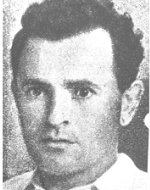Steinpers (Hirik), Abraham
Was born on February 5, 1905, in the city of Poltava, southern Russia, to a Hasidic family, where he received ultra-Orthodox education in a room and yeshiva and absorbed the life of the synagogue and the values of religious Judaism. And his older brothers were among the Jewish maskilim who were active in overthrowing the Tsarist regime.13 At the age of 13, under the influence of the spirit of the October 1917 revolution and to the displeasure of his parents, he stopped studying at a yeshiva and began studying at a Russian school He later studied at the Russian Gymnasium and was sympathetic to the working class at that time and being close to the Hechalutz movement, The family settled in Petach Tikvah in 1920. After a long period of hardships, the family arrived in Petah Tikva and settled in Petach Tikvah in 1947. The moshav was then a typical “Baron Colony” and had no Jewish workers. Improving working conditions and appalling salary conditions During the riots of 1921, Avraham was one of the defenders of the moshava. He and his two sisters died of his illness. His brother returned to Russia and he remained with his parents until he was forced to travel to France, as instructed by the doctor for healing and recovery from fever. After he left for Russia, he spent three years studying journalism. Before returning to Palestine, he changed his surname to Shteinpres and illegally arrived in Constantinople and from there he made his way to Israel. Avraham began working as a laborer in the Electric Company and was one of the leaders of the electricity lines in the Jezreel Valley. In Afula he met Judith, a daughter of veteran residents, and married her. During the bloody riots of 1936-1939, he was sent to work for the company in dangerous places such as Kakun and Tulkarem but never showed signs of fear. When he was eleven years old, he taught her to shoot a pistol “in case of need.” During his years in the Electric Company, he was involved in the labor market, active in the Histadrut and in Kupat Holim and an active member of the Haganah. In 1940, he was transferred to work in the Haifa area and, in addition to leaving for work in dangerous places, did not give up his part in preserving his area of residence in Hadar Hacarmel. On March 18, 1948, he completed his work and prepared to return to his home when he learned that a unit of four people had to go out to renew the electricity supply to the western Galilee communities that were cut off from the rest of the country. At the entrance to Arab Akko, Arabs attacked the four and massacred them in retaliation for the destruction of an Arab convoy of ammunition in the Haifa area – the day before – the four were brought to eternal rest in a graveyard at Kibbutz Ramat Yohanan. In Acre, from south to north, where the four fell, they were named “Derech HaArba’a” A book called “comrades who fell in” and this number increases image of a man who was a prototype of a pioneer, one Jewish labor and Jewish schools, dreams and believe in the establishment of a new Arab-Jewish Land of Israel.
